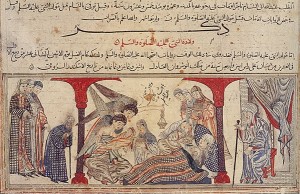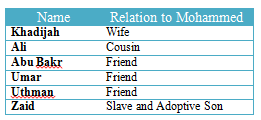Mohammed
By: Taylor Young, Lauren Tieman, Kendall Ladd
The Birth and Early Childhood of Mohammed
Mohammed was born into one of the most distinguished families in Mecca who were independent traders. His father died before he was born and death continued to be a prominent feature of Mohammed’s life. After his birth, Mohammed
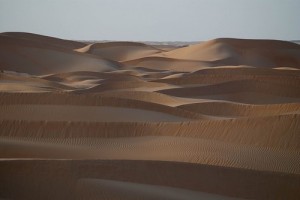
DSC_9532.jpg
by Alexandre Bourdeu, used under 
was sent to live in the desert which is a general custom for Arabs so that they could be free of the city and form a lasting bond with the desert. Mohammed’s mother died when he was around age 6 on their trip home from Yathrib, present day Medina, where they were visiting their relatives. Mohammed then lived with his grandfather who presided over Mecca’s Council of Elders (Muhammad: Legacy of a Prophet, 2002). When Mohammed was eight, his grandfather passed away and Mohammed then moved in with his uncle. When Mohammed was twelve, his uncle took him on a business journey to Syria where they met a monk who knew that Mohammed was destined for prophethood.
Click here for a complete timeline of important events in Mohammed’s life.
Legend
There are many legends surrounding Mohammed’s life. One particular legend involves Mohammed surviving an extraordinary event and going back to live with his mother in the city. While out in the desert during his early childhood, two men in white seized Mohammed and slit his chest open. When Halima, Mohammed’s nurse, found him, Mohammed explained that the men had taken his heart from his body and extracted a blood-clot that was supposedly a part of Satan in him. The men washed his heart with the water of Zamzam in a gold basin and then placed it back in Mohammed. Halima and Mohammed rushed back to his mother who calmed them both down and reassured them of Mohammed’s exceptional nature. After this event, Mohammed didn’t return to live with Halima in the desert, but instead he lived with his mother in the city for the next few years (Early Childhood of Muhammad, 2011).
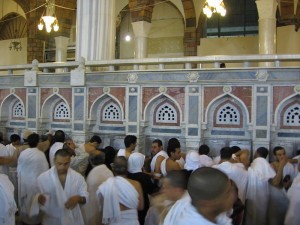
Zamzam Well in Mecca Saudi Arabia
by Mardetanha, used under 
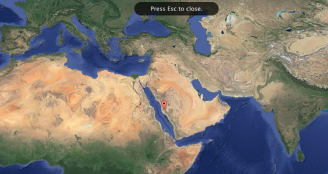
Mount Hira Cave
by MekarLar, used under 

Mount Hira Cave
by Nazli, used under 
Mount Hira (Cave)
610 C.E. was a life changing year for Mohammed. He had begun spending one month in solitary contemplation near Mount Hira (Cave), a tradition started by his grandfather. Toward the end of his private month, he felt a presence in the cave. The presence identified himself as Gabriel, the angel used by God to communicate revelations to humanity, whose purpose was to turn Mohammed away from the polytheistic practices that dominated the area.
Click for a virtual tour of Mount Hira (Cave) http://www.3dmekanlar.com/en/mount-hira.html
The First Revelation
The angel showed Mohammed a scroll with script in which he was supposed to read. However, Mohammed was illiterate and feared he would die never knowing the script. He was commanded twice to ‘Recite.’ Finally, he was grasped with extraordinary force from the angel, Gabriel and the first revelation was revealed to him. He was ordered to repeat the script to others, and then found himself alone in the cave again.
His First Follower
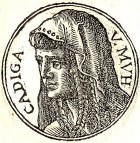
Khadijah
by Unknown, used under 
Mohammed returned from this unexpected day telling his wife, Khadijah, he had either gone mad or become a prophet. This initially startled Khadijah, depicted at the left. However she soon reassured him that he must have been called by God to be a prophet and serve as His messenger. She thus became his first follower.
After the First Revelation
Mohammed became frustrated after not receiving another revelation for at least two years. He returned to the mountain and was finally visited by the angel. He was comforted by the angel’s famous words:
By the glorious light of morning, and by the stillness of night – your Lord has never forsaken you, and He is not angry with you. Be certain – your future will be better for you than your past, and in the end God will be kind to you and you will be satisfied. Did He not find you an orphan, and gave you a home? Did He not find you lost and wandering, and showed you the way? Did He not find you in great need, and took care of you? As for you, therefore, never wrong the orphans, nor turn away those that ask your help; spread and increase your Lord’s blessings’
(Surah 93.1-11)
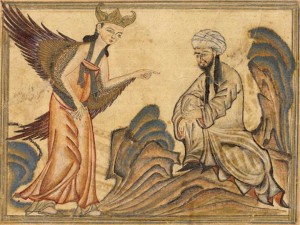
Angel Gabriel
by Unknown, used under 
He then received revelations for the rest of his life. Mohammed lived knowing the angel could come at any moment, and Mohammed no longer enjoyed any private time.
Mohammad’s Initial Followers
Mohammed was always careful to clarify his role in God’s work, in that he was only a prophet. He was not an angel and did not know the mind of God. He simply preached what he received. Additionally, accepting this role never once affected his humility. He knew he was the means of making the Divine Words known to humanity, and knew this was all at God’s discretion.
In his first 3 years of ministry, he gained only 40 followers. His teaching threatened the Meccan way of life, morally and economically, causing his followers to face heavy persecution through mockery and violence. This led the small group to flee the region and begin a journey toward Mecca.
Before Mohammed’s final journey to Mecca, Mohammed, along with his followers, began praying while facing Jerusalem. This is what had been customary, but on this day Mohammed received a revelation telling him to face Mecca as he prayed. Therefore, he turned around along with those who were praying 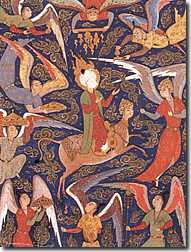 alongside him. This caused Islam to be more closely connected to the Arabs and Mecca (Holt, Lambton, and Lewis, 1977). Mohammed decided to perform the Lesser Pilgrimage (‘Umra) to Mecca. Unfortunately, Mohammed and his followers were stopped at al-Hudaybiya. After many days, a treaty was signed allowing Muslims to enter Mecca for three days the following year (Holt, Lambton, and Lewis, 1977). The next year, Mohammed led his followers back to Mecca and was able to enter the city after little conflict. However, instead of just staying for three days, Mohammed and his
alongside him. This caused Islam to be more closely connected to the Arabs and Mecca (Holt, Lambton, and Lewis, 1977). Mohammed decided to perform the Lesser Pilgrimage (‘Umra) to Mecca. Unfortunately, Mohammed and his followers were stopped at al-Hudaybiya. After many days, a treaty was signed allowing Muslims to enter Mecca for three days the following year (Holt, Lambton, and Lewis, 1977). The next year, Mohammed led his followers back to Mecca and was able to enter the city after little conflict. However, instead of just staying for three days, Mohammed and his
followers stayed for two to three weeks. During this time he made arrangements for the future administration of Mecca and the surrounding area (Holt, Lambton, and Lewis, 1977). Finally, Mohammed led the Hajj to Mecca in
| Mohammed ascending to Paradise |
March 632. Unfortunately, his health began to decline after this pilgrimage and was no longer able to lead the prayers. Mohammed
died on June 8, 632 (Holt, Lambton, and Lewis, 1977).
Mohammed’s Legacy and Traditions Upheld Today
Islam is actually a very diverse religion much like Christianity. There are believers who are very strict about their observance and other believers who are flexible in their observance (Gulevich, 2004). Certain traditions that are still upheld today include having formal prayer five times a day which is a very structured tradition (Gulevich, 2004). In order to prepare for prayer, Muslims must wash themselves (Gulevich, 2004).
| Did You Know?“The Kaaba is a single-room structure made out of stone, and shaped approximately like a cube. It’s about 50 feet high, 40 feet wide, and 33 feet deep. It is covered with a black silk ceremonial cloth onto which verses from the Quran have been embroidered in gold thread” (Gulevich, 2004). |
After this, they must dress in certain clothes (Gulevich, 2004). There are also two other traditions that were formed from examples that Mohammed set. These include memorizing the names of Allah and fasting. As stated in Gulevich (2004) Mohammed said “There are ninety-nine names of Allah; he who memorizes them and repeats them will get into paradise” (p. 156). Therefore, Muslims believe that in order to deepen their knowledge of God and strengthen their faith, they must memorize all 99 names (Gulevich, 2004). Mohammed also said that fasting should be used as a spiritual discipline (Gulevich, 2004). Finally, in order to honor Mohammed, Muslims recite the durud to invoke his presence and request guidance from him (Gulevich, 2004). There are also three very sacred cities to Muslims. These three cities were very important during Mohammed’s life (Gulevich, 2004).
Mecca
The holiest of these cities is the city of Mecca. Mecca is located in Saudi Arabia and is where Muslims travel annually for the Hajj just as Mohammed did (Gulevich 2004). The Kaaba is located at the center of Mecca and represents the original and monotheistic religion that Mohammed wanted to teach the Arab people (Gulevich, 2004). After Mohammed’s death, the Grand Mosque was built around the Kaaba (Gulevich, 2004).
|
Did You Know? About 1.7 billion of the world’s population today (about one-fifth of the population) are Muslim (Lunde, 2002). |
Medina
The second holiest city is Medina which is also located in Saudi Arabia. Medina is where Mohammed created the first community that was completely run by Muslim teachings. Here he also built the mosque where he prayed with his followers. Muslims typically travel to Medina before or after the Hajj to Mecca (Gulevich, 2004).
|
Did You Know? Mecca and Medina are considered to be so holy by Muslims that non-Muslims are not allowed inside. |
Jerusalem
Jerusalem is located in modern-day Israel and is considered to be sacred, though not as sacred as Mecca and Medina (Gulevich, 2004). Mohammed was supposedly standing on a stone within Jerusalem when he began his ascent into Heaven (Gulevich, 2004).
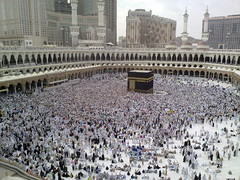
all pilgrims leaving Mina, many already in Mecca for farewell circumambulation of Kaaba
by Omar Chatriwala, used under 

prophets mosque in Medina-Saudi Arabia
by Jamal Nazar, used under 

Jerusalem Mt. of Olives
by Episcopal Diocese of Southwest Florida , used under 
